
Earlier this year I shared a Quick & Easy Kimchi Vegetable recipe, one that I make on a regular basis. Now I’m sharing my sister Nadalyn’s Scallion and Cabbage Kimchi recipe. Nadalyn and her family love this recipe so much that as soon as one batch is gone, she’s busy making another. When her son came home to work for a few months during the COVID isolation, he finished off the jar that was in the refrigerator. Before he went back to California, he finished off one of two jars from the new batch. She was thankful that he left one jar for her and her husband to enjoy.
While making the last batch, Nadalyn’s daughter took some process pictures and pictures of the final product so I could share this recipe with all of you. As soon as I get some room in my refrigerator I’m going to make Bobby and me a big batch. It looks and sounds absolutely delicious so I can’t wait to enjoy it for myself. We hope you enjoy this recipe as well.
Scallion and Cabbage Kimchi


A cabbage kimchi recipe that provides plenty of kimchi for many weeks to come. Easy to make, lasts a long time in the refrigerator, and filled with spicy deliciousness.
*See Kitchen Notes for more information, substitutions and related links.
- 1 large head Napa Cabbage* (about 4 pounds)
- 1/2 cup salt (for initial brine)
- 2 bunches scallions (green onions)
- 1 cup water
- 4 – 6 cloves garlic*
- 2 Tbsp ground ginger
- 4 – 6 Tbsp Korean red chili Paste*
- 3 – 4 Tbsp fish sauce (not the sweet kind)
- 3 Tbsp rice vinegar
- 1 scallion, chopped (optional)
- 1 large bowl
- food processor or blender
- protective gloves
- 1-2 large jars or containers (non-corrosive, airtight and sterilized)
Cut the end of the cabbage about 1 inch from the bottom. This allows for easy disassembling and less cutting.
Rinse each leaf in cold water. You can fill a clean sink or large bowl and do this quickly.
Slice each leaf lengthwise down the center and chop into 1 inch pieces.
Put cabbage in a large bowl, sprinkle with the salt and toss with your hands, distributing the salt thoroughly.
Let cabbage sit for at least an hour while you prepare everything else.
In a blender or food processor, combine water, garlic, ginger, fish sauce, chile paste, rice vinegar and one chopped scallion (optional)
Blend until garlic is completely ground. Let rest for about 5 minutes. Taste and adjust to your liking if needed.
Chop the scallions (green onions) in 1 – 1.5 inch lengths, both the white and green parts.
Taste the cabbage. If it is too salty, then rinse lightly and drain well. Dry the cabbage to remove as much of the water as possible. You do not want the cabbage too wet because it will make the kimchi sauce too runny as it sits.
Add the scallions to the cabbage.
Wearing rubber gloves, pour the chili sauce over the cabbage and scallions and toss until each piece is well covered in sauce.
Pack firmly into large sterile, non-corrosive, airtight containers. Pour any of the remaining sauce over the jarred cabbage (or as much as you want).
Leave to ferment in a cool dark place for a day, then store in the back of the refrigerator for at least a week* before eating. (I prefer to let it rest for 2 weeks, but others in my family can't wait that long.)
If kept cold, this kimchi will last at least a year.
Napa Cabbage – This is the best cabbage to use for Kimchi. Because it comes in different sizes, you might need to adjust the amount of sauce based on the size of the cabbage. The amount of ingredients in this recipe’s sauce is actually based on a HUGE cabbage (probably 5-6 pounds) that yielded 3/4 gallon of kimchi. Therefore, if you use a smaller cabbage (around 4 pounds), you might want to reduce the amount of sauce used. Just use your own judgement. Any leftover sauce can be refrigerator and used for other vegetables, OR you could reduce the amount of ingredients by 1/3.
Chili Paste – I prefer using a chili paste to chili flakes. To make your own paste, soak 1/4 cup of dried Korean chili flakes in 1/4 cup olive oil overnight. The flakes will re-hydrate forming a paste. Korean chili flakes are sometimes labeled Korean chili powder or gochugaru. If labeled “powder”, check for the graininess. Most Korean chili powders are coarse and that’s what you want.
Other vegetable for chili paste – This chili paste can also be used to make Kimchi with other vegetables such as daikon radish, carrots, bean sprouts and celery. I do not recommend mixing these vegetables with the cabbage since they age at different rates and do not keep for as long a period of time as the cabbage. Daikon, especially, has a shorter self-life and only holds up for a few weeks; therefore, it’s best to ferment it by itself. When pickled it will smell awful, but taste great.
In case you missed them, here are a couple of other great recipes Nadalyn has shared with us in the past. The grilled salad is just perfect for this time of year.

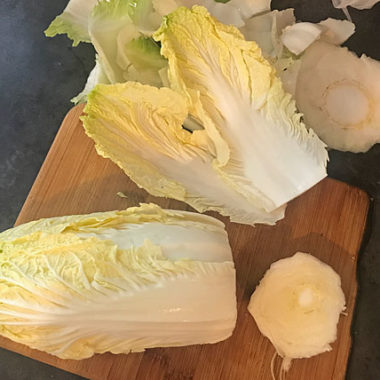
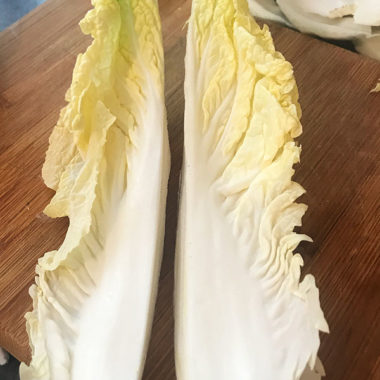

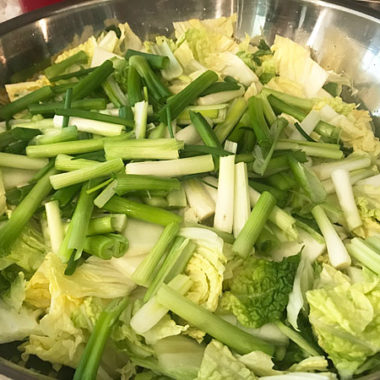
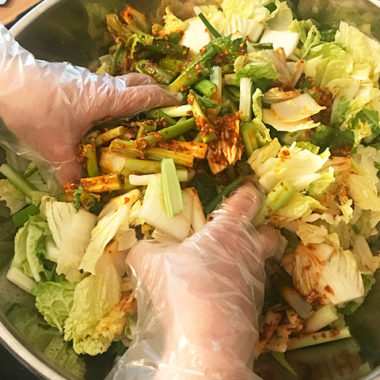
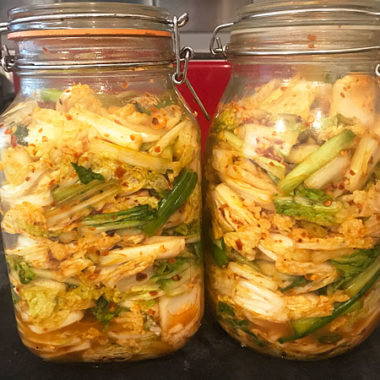

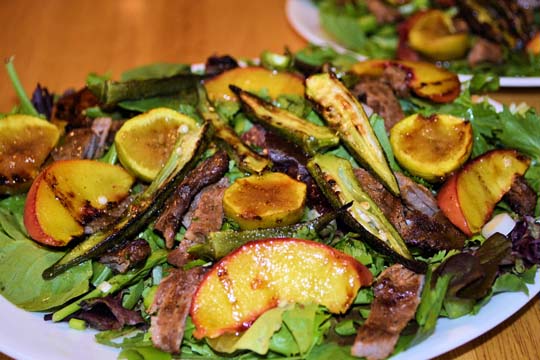

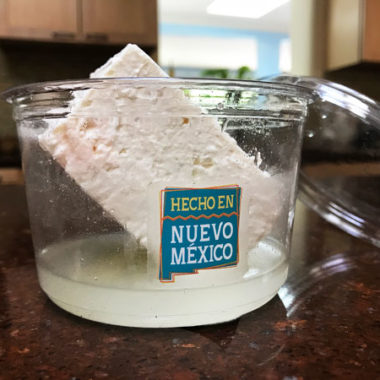

I love the idea of kimchee and understand it is really healthy to eat, but I do not do well with hot pepper or pepper paste. Can I leave it out or is it a necessary part of the recipe?
Oh Judee, the pepper is what provides Kimchi with its unique flavor. In leaving out the chile pepper, the result would be closer to sauerkraut than kimchi. You might want to check out come sauerkraut recipes. It has the same health benefits as kimchi. So sorry that peppers give you problems. My niece has the same problem so it’s hard for a chile addict like me to cook for her. 🙂 But as I’m sure you know, there are ways. Thanks for contacting me. cheers, MJ
You know MJ, I have never tasted kimchi, but I’m betting it’s sort of like southern chow chow — which I really like. Is there a store brand that you like (I know that’s a hard one to ask) that I can try? Thanks for inspiring me with a new recipe!
I finally had my first taste of kimchi last week! Still on the fence, but I will reserve judgment until a couple more samplings 🙂
I kind of draw the line at kimchi, but I probably shouldn’t. This sounds so interesting.
It is tradition in my family to make all sorts of pickles and fermented vegetables at home; they are so much better that those store bought ! Also, I have that size glass jars to preserve whatever comes into the season. This is the one I have to do !
Thanks Davorka. I hope you enjoy! Nothing better than homemade.
Hi MJ. Thanks so much for sharing this recipe and the step by step photos. I still have plans to make your first kimchee recipe and would love to give this one a try soon. I’ve only had mass market made kimchee and was underwhelmed. I want to try the “real stuff”.
Thanks Lea Ann. I agree, commercial brands are usually underwhelming on most everything. 🙂 Hope you get a chance to make it.
Loving the process pictures (always helpful) and finding myself especially relating to Nadalyn’s son coming home during covid and clearing out the fridge ;o) (well, our fridge sure seems a lot more full these days anyway, haha!). Great looking kimchi Nadalyn – I’ve tried a few from whole foods but haven’t really found ‘the one’ sensing that maybe I should make my own, thank you for the inspiration! I have Korean chili powder (coarse) and gochujang — can I use gochujang as the paste in this recipe or would you still recommend making it from the powder? cheers.
Thanks Kelly. Those are great pictures aren’t they. Nadalyn and my niece did a great job putting this post together and I am so thankful! I had the feeling you could relate to your son emptying out the fridge. 🙂 I’ll pass your question to Nadalyn, but from my knowledge of gochujang flavor vs. a paste made with gochugaru (the Korean chili flakes), they are a little different. There are several other ingredients added to gochugaru to make gochujang. Ingredients such as glutinous rice, sesame seeds, fermented soy beans and few other ingredients. So you might be able to substitute it, but it would yield a little different flavor.
Hi, Kelly. I agree with MJ about the gochujang vs gochugaru. I personally prefer the latter. What I use is mostly just flakes in oil. That way I can control the taste I want from the other ingredients. I’ve never used Korean chili powder. The coarse powder could work but I suggest whatever you choose for your heat that you start out small and adjust as needed for the heat you want. We tend to like ours on the hot side. Keep in mind that it doesn’t get milder as it ages, it only gets hotter.
I love me some kimchi but I’ve never made it. I had someone bring me some authentic jars many years ago and I loved it. Would like to make my own and thank your niece for taking such great pics to guide me!
Thanks Debra. Lucky you to actually have authentic jars! I looked them up to see what they look like. What a nice jar to have in the kitchen, but pretty big. 🙂
it’s odd but i don’t like kimchi. i love sauerkraut so you’d think i’d at least like kimchi… sorry – that sounds a bit mean of me!
That is interesting. Because I love kimchi, but I don’t like sauerkraut. Go figure. 🙂 Thanks Sherry.
Great to see Your family favourite kimchi recipe , , , in Australia Korean food popularity is almost equaling our very beloved Vietnamese and is available everywhere. Ours is most often made with gochugara rather than gochuyang, ie the flakes rather than the paste . . . daikon radish almost always finds its way in as often does a Granny Smith apple with perchance fewer shallots (scallions) added to the wombok . . . oh there are so many variations to this wonderfully healthy dish almost used as a probiotic medication hereabouts . . . it might even keep the Monster away !!!
Thanks Eha. Nadalyn does use gochugara, but rehydrates it in oil to the make the paste, so it’s not really a true gochuyang (something I eat ALL OF THE TIME). 🙂 A Granny Smith – now that sounds really interesting and I would think it would add a little bit of sweetness to the results. And YES, there are a ton of variations so like so many other recipes, it’s finding what you like. Anything to keep the monsters away. 🙂
Hi, Eha. You are so right! The variations on kimchi recipes are endless. I have seen recipes that used apples, some that include sugar, some that add dried shrimp or fermented shrimp, and on it goes. Actually, a teaspoon of sugar isn’t bad. I’m sure the apple is good also. I have been experimenting with recipes for almost ten years and my poor family has had to eat a lot of kimchi. This recipe is very basic but packs a lot of flavors. I nixed other veggies mixed in because, as it says in the post, they don’t age at the same rate. When our son isn’t around, a jar of kimchi can last several months. The daikon was the first thing to get omitted because it fermented faster than everything else and my husband couldn’t take the smell. I do the daikon separately now so I can discard it if it gets too pungent.
Nadalyn – thank you so much for adding your comments ! Very much appreciated ! I have not made kimchi for a little while – well, this post and both of your comments have just put certain ingredients on my next on-line shop ! Thank you . . . and some ‘refresh’ reading will also be done . . .
So I’m trying to figure out which kimchi I like. I am not so good with fermented foods but my son tells me I am crazy. Perhaps this is it!
Thanks Abbe. It took me a while to enjoy fermented foods, but it finally happened. So far Kimchi is my favorite.
My niece (a vegetarian) has made comment that she is experimenting making kimchi at home. I will forward your post on to her, I’m sure she will love it. Looks and sounds fantastic! I can see why it doesn’t last long!
Thanks for sharing the post Jan!
I really need to start making my own kimchi. I’ve done it before, but it’s been years. Usually I just buy some from the market — good, but not great. This looks great! Thanks.
Thanks John. I agree. I haven’t found a storebought Kimchi that I’m crazy about. Scratch is the way to go.
I like fermented vegetables. Awesome that you made our own from the scratch.
Thanks Angie.